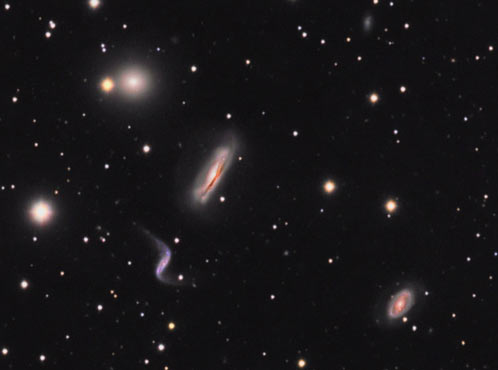Last month’s Jim’s Corner featured the introduction ofHickson Catalog of Compact Galaxy Groups.
Most of these Hickson groups are difficult, if not impossible to locate and observe with most backyard telescopes. Except NGC 3190 Group aka Hickson Compact Group 44

NGC 3190
Alternate: Hickson Compact Group 44
Leo
RA 10h 18 m 05.6 s
Dec +21º 49′ 58”
Magnitude 11.1
NGC 3190 Group
Alternate: Hickson Compact Group 44, including NGC 3185, NGC 3187, NGC 3193
Leo
RA 22h 36 m 20.4 s
Dec +33º 59′ 06”
Magnitude 16.7
NGC 3190 was discovered by William Herschel in 1784.
The Hickson Compact Group 44 group of galaxies lies somewhere between 60 to 90 million light years away from Earth. The group includes NGC 3190, which is a magnitude 11.1 galaxy with a prominent dust lane. The elliptical galaxy NGC 3193 is slightly brighter at magnitude 10.8. NGC 3187 is at magnitude 14.0. The barred spiral NGC 3185 is at magnitude 12.0. There many other very faint galaxies tucked away in the image. Both NGC 3190 and NGC 3185 have a faint halo of stars surrounding each galaxy.
NGC 3190 is retreating from Earth at roughly 1271 kilometers per second. NGC 3190 shows signs of gravitational interaction with its fellow compact group members with its dust lane warped on the side nearer to NGC 3187. There is also a very subtle smudge of light between NGC 3190 and NGC 3193, which seems to be a bridge of stars being shared between the two galaxies.
This group of galaxies was observed in the my 11” aperture SCT comfortably. A dark, moonless and light-pollution-less night is needed. Make sure your eyes are fully dark adapted. The November 2017 issue of Sky and Telescope magazine, in its article on Hickson groups offered that Hickson Compact Group 44 could be seen with an 8” aperture and was the easiest of the Hickson groups to be observed.